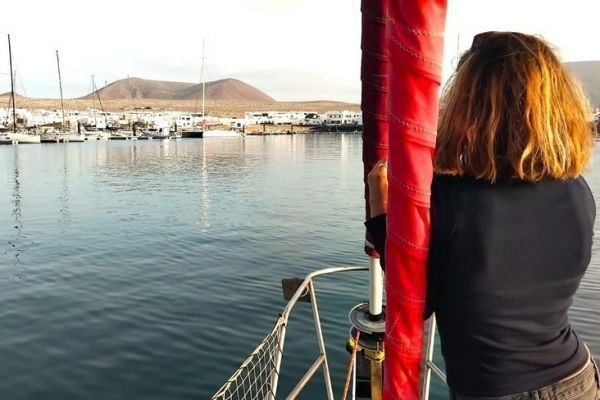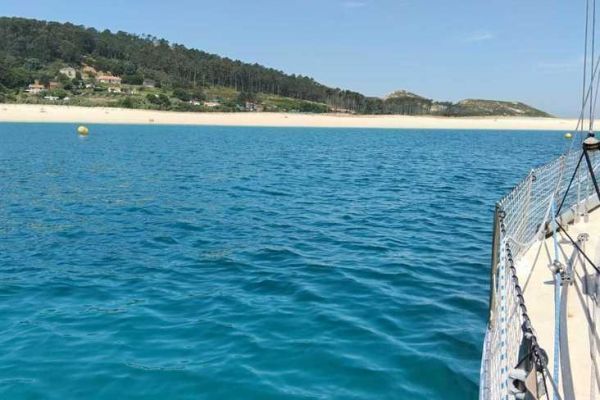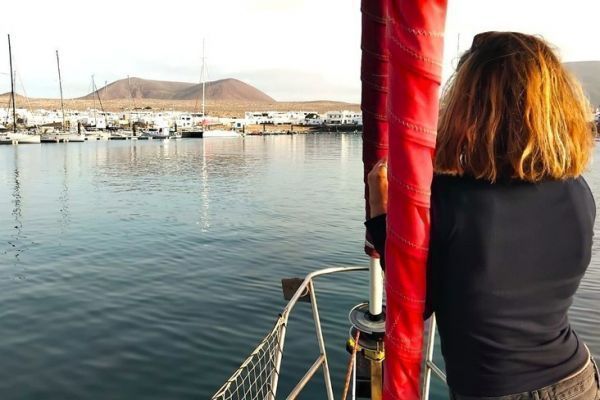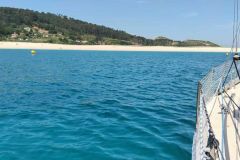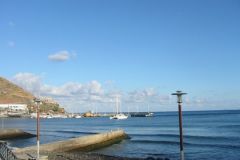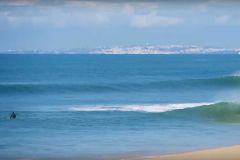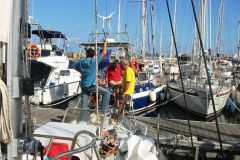After a first stage from Lorient to Portugal olivia climbs back aboard her sailboat to continue on to the Canaries.
When the stars don't align.
july 17, 2025: shortly after my departure from Lorient station, the train is stopped on the track for an indeterminate time and it's announced that it will be going to Rennes instead of Nantes. Anthony picks me up two hours later in Redon and we head for Nantes airport, where our flight to Lisbon is due to take off.
Finally seated in the plane, ready for take-off, the pilot announces that due to a technical incident, the flight will not depart, and that it can be replaced by another flight, in just four days' time... Impossible in view of our schedule, as the trip is to be completed in 12 days flat!
We opted for a bus journey with Flixbus, departing that evening at 11.50pm and arriving in Lisbon at 8pm the following day. With a small change of bus, taking us through Lisbon by metro, we reached Peniche on July 18 at 10pm, a journey of almost 24 hours by bus instead of the hour-long plane journey initially planned: a good start!
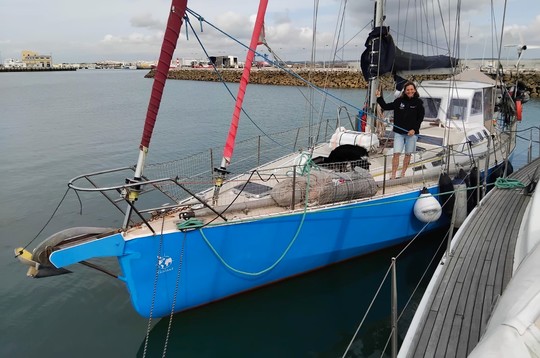
Dorothée, Anthony's sister, who arrived the day before, welcomes us aboard Galaad with a broad smile and a freshly prepared dinner. She will accompany us to Graciosa. We "lost" 24 hours due to this setback, and it will take us a few days to recover from the accumulated fatigue.
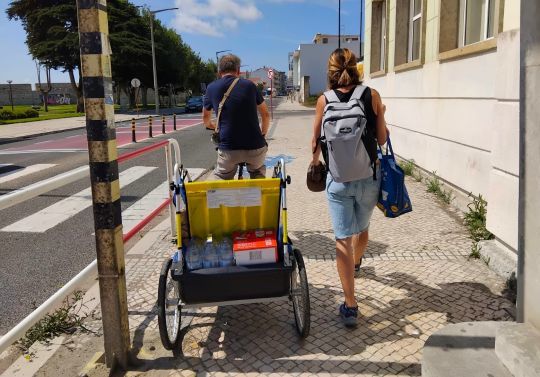
The next morning, we refuel, prepare the boat and set sail from the Péniche port at 5pm, heading for an anchorage in front of the port of Cascais, at the mouth of the Tagus.
Arriving in Cascais at around 2 a.m., we had to make an unscheduled repair: the autopilot was acting up, something it had never done before. We can't envisage crossing to the Canaries without being able to count on this precious crew member.
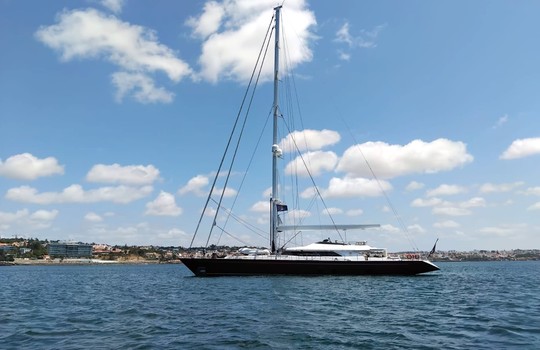
Once the initial repairs have been made, we refuel and set off again in the early afternoon for Cape Sao Vicente.
When the Portuguese trade winds frown.
After a fine night's downwind sailing, the day dawns with a weather setback: the Portuguese trade winds are set to blow for 3 to 4 days at between 25 and 35 knots, gusting to 40 in the zone stretching from Madeira in the west to Lagos in the east, the very zone we'll be sailing through on our way to the Canaries.
There was no time to wait, as Anthony and Dorothée had to leave by July 29 at the latest, with plane tickets already booked from Lanzarote.

The only way to make any progress will be to sail along the Gulf of Cadiz towards Gibraltar, then round off our course by forming a "spoon" along the Moroccan coast as the gale shifts to the west.
In the meantime, a shy Risso's dolphin feasts our eyes with a few furtive apparitions as we round Cape Sao Vicente under motor power. As we rounded the cape, we were surprised by a violent acceleration of the wind due to a site effect.
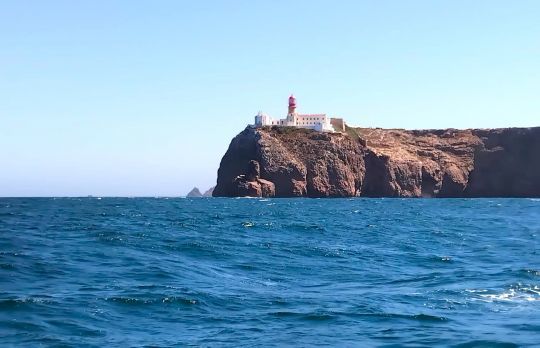
Following the coastline as closely as possible, we anchor in the small cove of Baleeira in the late morning. There, Anthony will attempt a second autopilot repair, while Dorothée and I carefully tidy up the boat.
After a short night's sleep, we sulk at the first wake-up call at 3 a.m.: the wind is still blowing hard and we don't feel like getting up. At 6am, the second wake-up call is the right one: the wind has really died down. We take the opportunity to make a cup of coffee and admire a sunrise worthy of the world's first mornings.
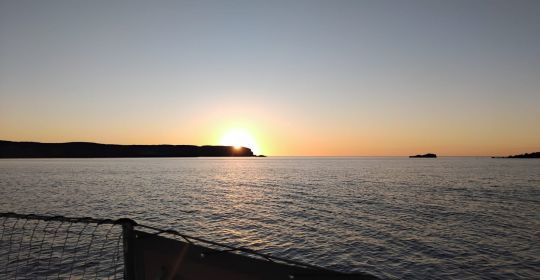
It's July 22, a month and a day after we left Lorient ( Olivia did the first leg to Peniche at the end of June ). We leave the old continent, skirting its southernmost tip from afar, and head for Morocco. This is the start of our famous spoon route, surfing along the edge of the gale.
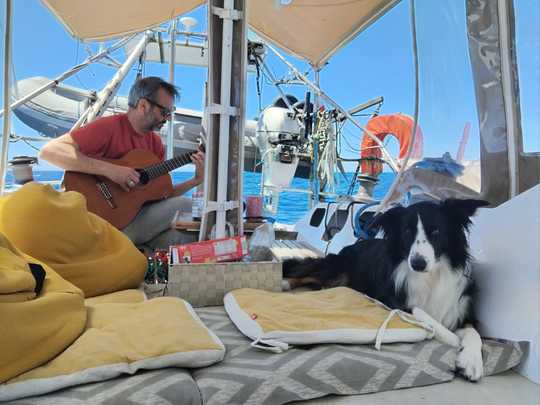
This first sunny day was rather calm, with a moderate northerly flow seeing us make good progress. Same during the night and the following day. On the other hand, during the first night and the second day, our eyes are riveted on the AIS: a ballet of steel behemoths come and go.
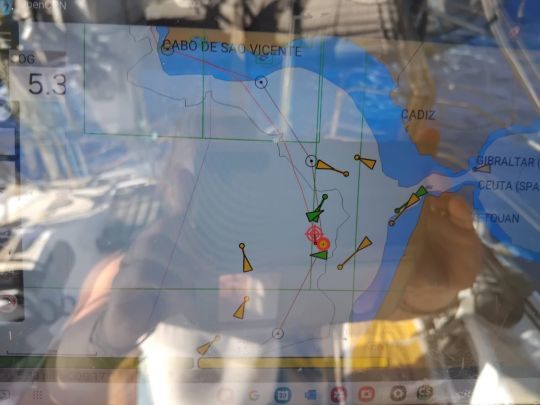
The traffic via Gibraltar keeps us on our toes as the collision courses multiply: in addition to a nice spoon, our wake now draws beautiful arabesques.
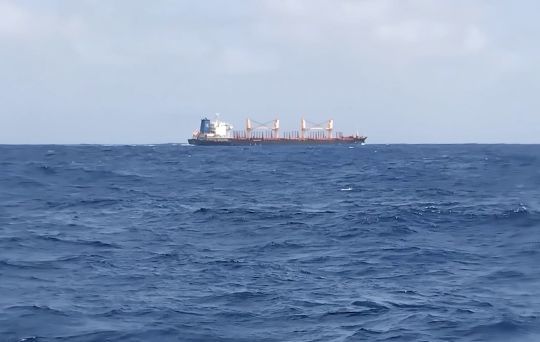
On the third day, as we approached El Jadida, the gale didn't shift as expected: it stuck to the Moroccan coast. As best we could, we slowed our pace by reducing sail, but the sea was now rough and heavy, with 30 knots of steady breeze whistling through the shrouds.
The sun sets on a choppy sea and the pilot struggles to manage the required course. We take the helm for a few hours to relieve the recovering mechanism.
We don't want to consider a stopover in Morocco: in this wind sector, the safety of the approach is not guaranteed and the shelters are not so reliable. So we're taking it easy: not too much canvas, so as to be able to handle the helm manually, and not too much canvas, either, so as to remain maneuverable.
The next day, July 25, was a gloomy one. The sky is overcast, the waves are gray and the swell is having fun with the mood swings of the gusts. All viciously playing with our nerves. Fortunately, during the following night, the wind dies down. In the early hours of the morning, in damsel-like weather and to the sound of a Latin beat, we set a direct course for the Canaries: vamos a Graciosa!
At last, a direct course to the Canaries!
The sun is shining, it's warm and the ocean has taken on its Alizé hue. Shortly after breakfast, a squadron of exocets hover around the boat, no doubt trying to escape the onslaught of a dolphinfish on the prowl. The trolling line is launched.

At the end of the morning, a school of Atlantic bottlenose dolphins escorts us: their sequined coats seem almost unreal beneath the surface. A shower of seawater on the rear skirt and we're in the opposite mood to the day before.
Floating here and there, brown specks that we think are clumps of sargassum are actually sea turtles! We realize this when we come very close to one!
The Loggerhead sea turtle or Carreta Carreta is a widespread species in the Canaries, and is particularly common in spring and summer. Weighing between 120 and 180 kg, this species evolves on the surface of the water. Its diet is omnivorous, feeding on algae, jellyfish, small fish and squid.
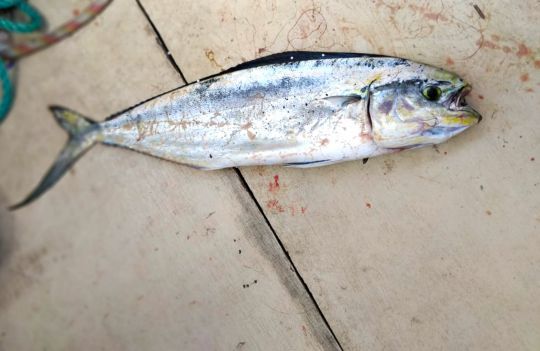
Fish! At the end of the line, it's bustling and struggling. The beautiful Coryphene bream is quickly reeled in on the rear skirt. Our first catch since leaving Brittany. The captain prepares it in ceviche: cooked in a lemon and lime juice with a few coriander seeds and a drizzle of olive oil. A delicacy bursting with protein and iodized vitamins. What a glorious day!
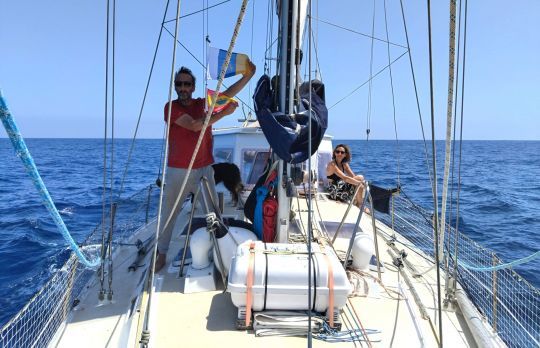
At this speed, our arrival in Graciosa would take us into the night, but we want to get there by day. We slow down for the night. We're having fun imagining Poseidon and Aeolus getting together to give us the idyllic day's sailing we've just had as a present for arriving in the Canaries.
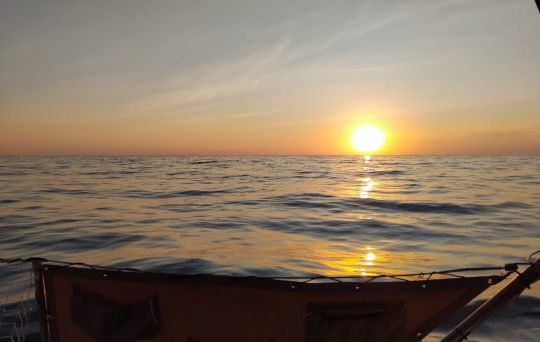
At dawn on July 27, after 5 days' sailing from southern Portugal, the silhouettes of Lanzarote, El Roque Del Este and Graciosa appeared on the horizon.
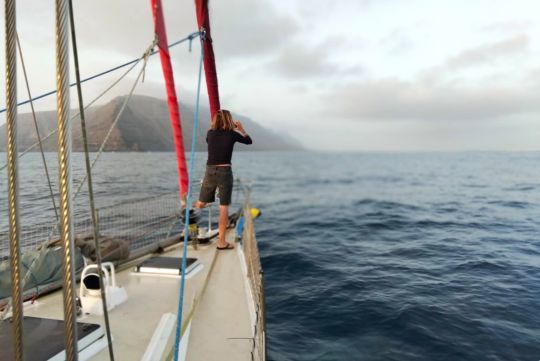
While on the port side, the port of Orzola with its white houses stands out against the black basalt, we pass the solemn Punta de Fariones.
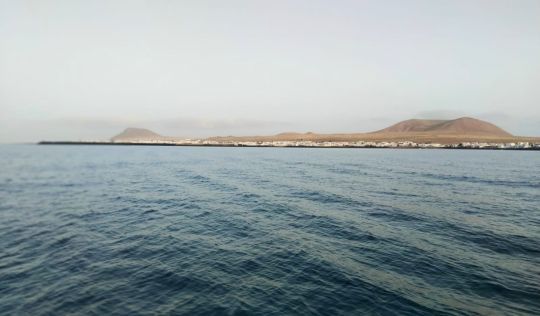
The vertiginous Miraduro de Lanzarote, a long cliff dominating the channel separating the island from Graciosa, impresses us. We enter the port of the sleepy village of Caleta del Sebo.
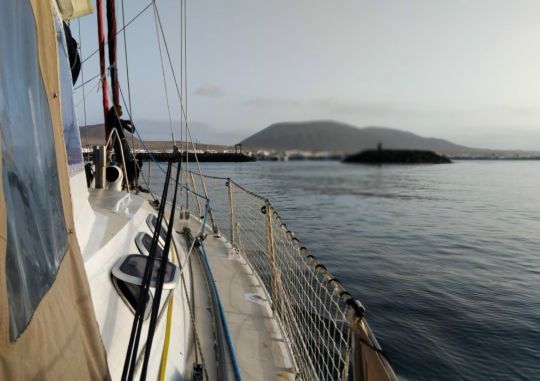
The port agent greets us, as he should, with the arrival formalities. Fortunately, we had reserved our mooring in advance, as is now customary in all Canarian ports.
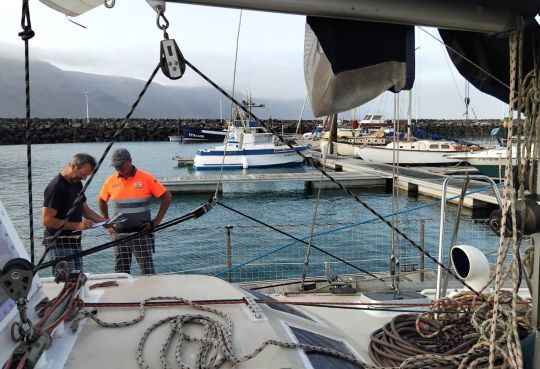
Once Galaad is securely moored, we stroll out onto the pontoon with a slight feeling of "land sickness". The water is turquoise and what a surprise to see a stingray flying over the white sandy bottom.
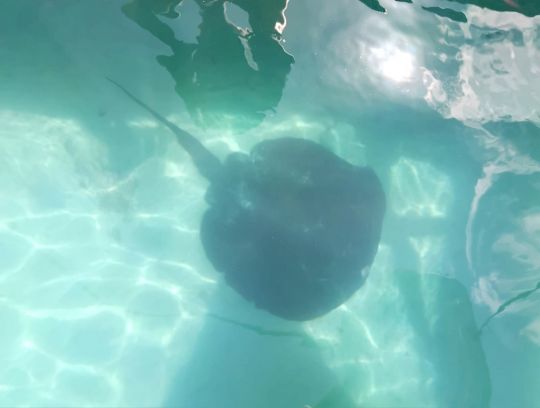
Dorothée and Anthony have 48 hours to make the most of this pretty volcanic rock, and it's with great emotion that we end this second leg of our trip, with the island of La Gomera in the west of the archipelago as our final destination.

 /
/ 